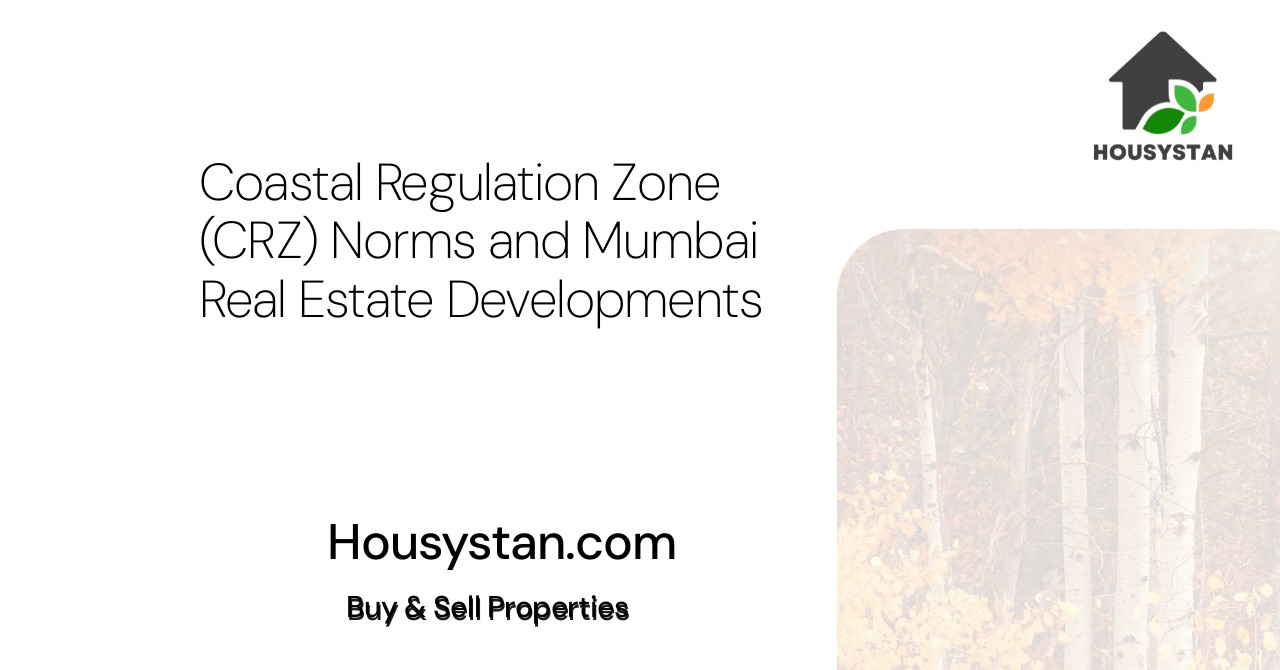Coastal Regulation Zone (CRZ) Norms and Mumbai Real Estate Developments
Read latest blogs and articles from Housystan

The Information mentioned here was last updated on:
27/11/2025Understanding Coastal Regulation Zone (CRZ) Norms in Mumbai
Mumbai, the city that never sleeps, is a bustling metropolis perched along India's western coastline. Its prime location has made it a magnet for real estate development. However, being a coastal city also means adhering to specific environmental norms designed to protect fragile ecosystems, which brings us to the Coastal Regulation Zone (CRZ) norms. These regulations significantly impact real estate developments in Mumbai. Let's dive into what CRZ norms are, why they exist, and how they influence the city's skyline.
What Are Coastal Regulation Zone (CRZ) Norms?
- Verified Tenants/Buyers
- Unlimited Property Listing
- Zero subscription/charges fee
Coastal Regulation Zone norms are policies set by the Government of India to control development along coastlines. Established in 1991 under the Environment Protection Act of 1986, these norms aim to safeguard coastal environments from unregulated development. The main objectives are to protect natural resources, prevent coastal erosion, and ensure sustainable development along India's vast 7,500 km coastline.
Categories of CRZ
CRZ zones are categorized into various types, each with distinct regulations tailored to the sensitivity and type of the coastal area:
1. CRZ-I: This zone deals with ecologically sensitive areas such as mangroves, marshes, and coral reefs. It also includes the area between the low tide line and high tide line, where no construction is generally allowed, except for defense or strategic purposes.
2. CRZ-II: Refers to areas that have been already developed up to or close to the shoreline. These areas include urban settings where development is allowed but strictly regulated to maintain the existing status quo.
3. CRZ-III: Encompasses relatively undisturbed areas, including rural areas and settlements. Here, new construction is significantly restricted to prevent urban sprawl.
4. CRZ-IV: Covers coastal stretches in the union territories and the water area up to 12 nautical miles into the sea. Unlike the other zones, regulations here focus more on pollution control.
Why CRZ Norms Matter to Mumbai
Mumbai's development story is akin to a double-edged sword. On one side, there’s the need for expansion and infrastructural growth to accommodate its burgeoning population. On the other, there’s an urgent need to preserve its fragile coastal and marine ecosystems.
Historically, improper land-use planning and unregulated development have led to environmental consequences like increased flooding, erosion, and loss of biodiversity. CRZ norms help backpedal these trends by ensuring that real estate development takes into account environmental sustainability.
CRZ Norms and Real Estate Developments
Mumbai is often touted as India's financial powerhouse, and real estate here acts like a pressure cooker, compressing numerous interests and investments into the city's limited land area. This makes CRZ norms a subject of intense focus for developers:
- Balancing Development and Conservation: The crux of CRZ norms is to strike a balance between the city’s developmental needs and environmental conservation. Builders and developers must ensure that their projects are compliant with CRZ regulations, which can dictate limits on building height, density, and design.
- Regulatory Compliance: To embark on new real estate projects within the CRZ zones, developers are required to obtain clearances from both state governments and central regulatory bodies. Non-compliance can lead to legal battles, fines, and halted projects, making adherence to CRZ regulations critical.
- Effects on Property Prices: Real estate within CRZ-II areas is especially valuable due to both its proximity to the coast and the city center. However, the regulations often cap the development potential, affecting the supply side of the market. This can contribute to elevated property prices in these sanctioned zones due to the scarcity of buildable land.
- Innovative Projects: Given the constraints, developers often become pioneers in sustainable and green architecture. Ensuring minimal environmental impact, these innovative solutions help foster eco-friendly and energy-efficient living spaces that satisfy CRZ norms as well as consumer demands.
The Evolving Face of CRZ Regulations
Over the years, the CRZ regulations have undergone various amendments to stay aligned with the changing environmental as well as economic realities. These revisions aim to provide developers more latitude while keeping environmental protection at the core.
- CRZ 2019 Notification: The introduction of the CRZ 2019 notification aimed to make regulations more flexible by demarcating DP (Development Permission) and NDZ (No Development Zone) more clearly. This change was intended to speed up clearances for projects while still maintaining ecological integrity.
- Addressing Climate Impact: Amendments have considered the increasing threats posed by climate change. The focuses have been on promoting hazard lines based zoning rather than rigid bans, to mitigate natural hazards proactively.
Challenge and Opportunity
The relation between CRZ norms and Mumbai's real estate sector is not just a regulatory topic; it’s a continuous dialogue between nature’s rights and human aspirations. The sector consistently faces the challenge of transforming this dialogue into on-ground projects that cater to both interests.
On one hand, developers may view these regulations as impediments due to the extra compliance and oversight. On the other, they represent an opportunity to innovate sustainable urban solutions that attract environmentally-conscious buyers.
The impact of CRZ norms extends to civic amenities and public spaces, ensuring that beaches and coastal areas remain accessible to the public and aren't consumed entirely by private interests.
As with many regulations, CRZ norms serve multiple stakeholders—from policymakers, environmentalists, to developers—each with legitimate concerns and objectives. Understanding these nuances promises not just informed debates but also pathways to harmonize development with sustainability in this vibrant city.